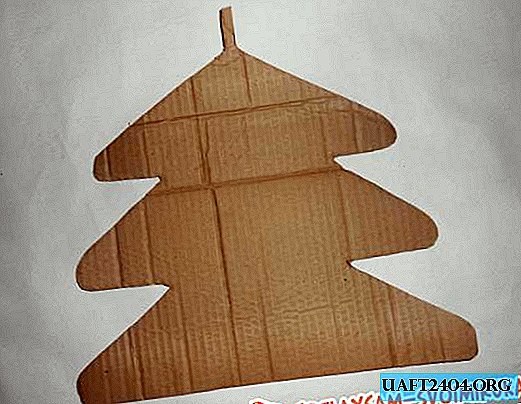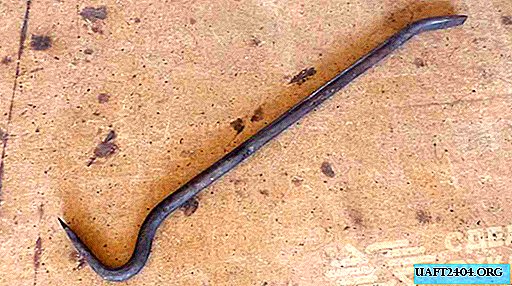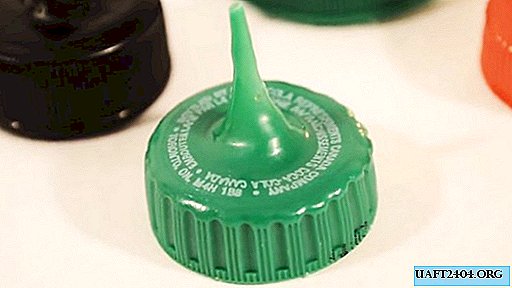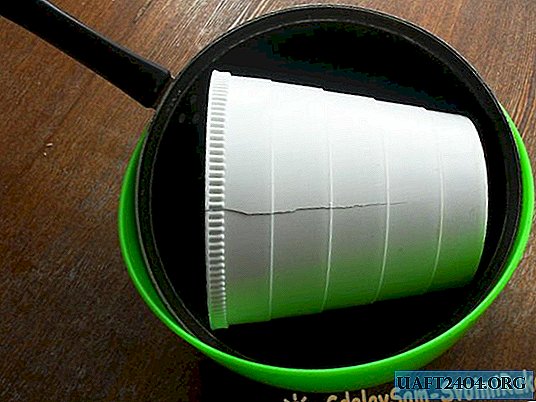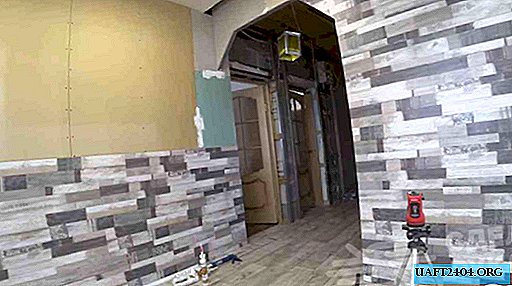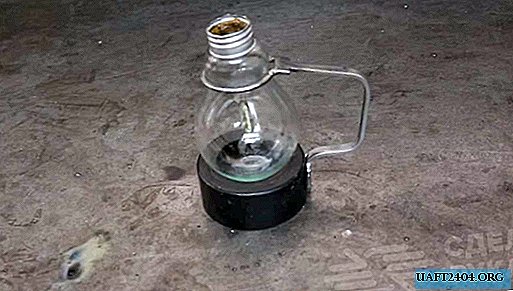Share
Pin
Tweet
Send
Share
Send

I decided to write an article on how to make a knife. The main idea is that all work will be carried out manually (with the exception of drilling and heat treatment). The idea came about because there are many articles that say that for making a knife it’s enough to have a few files and a drill on hand, or something like that. I was interested to know how long the whole process would take, and whether I would have to cheat and use power tools. By creating a knife in this way, I got a wonderful experience. All the work took a lot longer than I expected. And at the end, I was inspired with new respect for the people who make knives manually. In general, I am pleased with the result, and I hope that this article will help everyone who wants to try to make a knife with their own hands.
Creating a knife layout



I tried to make a knife of maximum size, using a design whose contours are most suitable for the size of the disk. Thanks to the model of the knife, made by me from thick paper, it was easy for me to transfer its outlines to the surface. For this procedure, I used a thin rod marker. This may seem like a trifle, but, in my opinion, this detail is important. Compared to a conventional marker, thin leaves a more accurate line. If the line is too thick, then when cutting the workpiece, you can make a mistake.
Blank cutting



Having mounted the disk on the desktop, I began to cut out the approximate shape of the blade using straight cuts. If you have never used a hacksaw for metal, make sure that its blade is fixed correctly, the teeth should be directed forward. The hacksaw should be cut when pressed "on its own."
Bending




In order to cut a curved portion of the handle, for convenience, it was necessary to make several perpendicular short cuts along the entire bend. Then, working with a hacksaw at a slight angle, I cut each piece. Short cuts make it much easier to cut bends.
Initial file processing




To improve the shape of the workpiece, I attached a block of wood to the desktop and fixed the blade on it with clamps. This allowed to process the edges with a file. At the same time, the blade was conveniently and securely fixed. I also used the file to identify areas that need more work. The design provided for a slight bend in the butt, and I applied a flat part of the file to check the progress of work on this bend. If there was a flat area on the butt, it can be easily detected with a file.
Finishing the workpiece



I used several types of files to get as close as possible to the shape displayed by the marker. At this stage, the workpiece began to look more like a knife and it was already more difficult to detect flaws in the eye. If there was a place to work on, I adjusted the shape with a marker and then worked on the workpiece to a new line. This line was needed so as not to overdo it and not spoil the design. The last photo shows the blade after shaping it with a file and sandpaper. I do not have a photo of how I grind the blade. At this stage, the traces left by the file were deleted. I started with grain P150 and reached P220.
Shank Drilling





Initially, I planned to make a sharpening rib with a high cutting edge, but I did not want to test my limited abilities. The saw blade is made of a sufficiently thin material, and I would not be able to file with a file the sharpening edge with a cutting edge, which I wanted. We will return to this topic later. At this stage, I measured the location of the rivets, cored and drilled holes using a cordless drill.
Cutting edge preparation



I applied paint with a marker along the future cutting edge of the blade. Then, using a drill of the same thickness as the blade, I scratched the mark exactly in the middle of the line of the blade. In the last image, this line is poorly visible, but it is there. This mark will be convenient when file cutting the edge, so as not to make it with an uneven inclination.
Cutting edge formation




To form the cutting edge, I used a file with a large notch, at this point I realized that I did not have sufficient skills to manually grind the sharpening rib. Therefore, I chose the option with a smoother angle, working with a file from the edge and moving to the butt. I'm new to this, so I chose a more conservative method for removing stock. After the cutting edge was normally machined, I walked with P220 emery paper all over the blade.
Finished blade

Here is the blade after shaping, file processing, sandpaper. Ready for heat treatment.
Hardening




Before continuing, I would like to note that heat treatment can also be carried out on an open wood fire, but I would not recommend this. The thing is that to me this method seems unsafe. So I took advantage of my mini-mountain. If you have nothing of the kind, in fact, you can use third-party services to heat treat the blade. There are some companies that are ready to perform heat treatment. For the money, of course. I will explain how I did it. He made a fire using wood raw materials. As a blacksmith's fur, I used a hair dryer attached to the pipe. I turned on the hairdryer and heated the charcoal to red. It did not take much time. I put the blade on the fire and heated it until it stopped magnetizing. Then he tempered it in a container with peanut butter. The last photo shows what the blade looks like after hardening. Despite the fact that it is possible to conduct heat treatment on an open fire, I do not recommend it.
Vacation




Then it was time to spend the blade vacation. First, I cleaned the scale with sandpaper, which remained after hardening. I set the temperature in my oven at 190 degrees Celsius and put the blade in it for 1 hour. An hour later, I turned off the oven and left the knife in it to cool to room temperature without opening the oven door. You can observe a light or bronze tint, which the blade acquires after vacation. After this procedure, I processed the blade with P220 sandpaper and then switched to P400. In the last photo, I use P400 sandpaper, wrapping it in a bar. I carry out the processing from the shank to the tip in only one direction. This treatment makes the surface uniform.
Sawing a handle blank




Using the blade as a sample, I plotted the handle on a wooden block. The handle will be walnut. Here again, I took advantage of the timber and clamps, and cut off two pieces each 0.6 centimeters thick. In a state of inspiration, I hurried with cutting a tree. Wait a bit to think about the course of action, and I could do it with less effort, and probably with a better result. My first mistake was trimming the excess part. It can be used to clamp during cutting. Here, my inexperience manifested itself, and, as a result, more work was done. Although, in the end, it was possible to make two parts suitable for the handle.
Grip preparation for bonding





So that the handles fit well on the shank after gluing with epoxy resin, using a flat surface and sandpaper, I made one side of each part as flat as possible. So for sure there will be no gaps after gluing. At this place I also decided on the shape of the handle, and in order to be finally convinced of this, I drew its approximate outlines. Then I again shifted the shape of the shank to the wooden part of the handle. He sawed a rough shape with a jigsaw on one of the parts, and then, applying it to the other, transferred the circuit to the second. This operation gave me the opportunity to make approximately the same parts, which will be convenient when gluing. The last photo shows a fitting to check that all parts of the shank are covered with wood.
The formation of the upper part of the handle




Again, it's time to work with sandpaper and give a more accurate shape. At this stage, it is important to finally form the mold for the forging or the upper part of the handle, because after gluing it will be more difficult to process. And also processing these parts after gluing, you can scratch the blade. Therefore, I have achieved the final formation and processing of this part with sandpaper P800.
Preparing Rivet Holes




Having drilled one hole for rivets in a tree, I inserted a drill of a suitable diameter into it to fix this axis. In other words, this was done to fix in order to avoid errors when drilling the second hole. I did the drilling of the other side of the handle in the same way, making sure that the corresponding holes line up in one line.
Making rivets



As a rivet, I used a stainless steel rod with a diameter of 4.7 millimeters. Before applying a layer of glue, I treated the glued surfaces with acetone or alcohol to clean from dirt, dust or oil.
Glue application




After drying, I mixed epoxy glue and generously applied it to the parts of the handle and rivet. Then I fastened everything with clamps.
Giving the handle the right shape




After drying the epoxy glue, I cut off the excess parts of the rivets with a hacksaw for metal. After that, he began to form the handle using a rasp.
Grinding a knife handle




With a rasp, I gave the hilt an approximate outline. Further, the matter remained with various files and sandpaper of different grain sizes. The grain has reached the P600.
Handle varnishing



Finally, I brought the handle to the desired shape. Before I started varnishing, I cleaned it with acetone. I applied 5 layers of Danish varnish to the hilt.
Blade sharpening


Finally, I sharpened the knife on the grinding bar. It was wrapped with sandpaper P1000, P1500 and P2000. A piece of leather was also attached to it. Using a similar grinding bar, I can sharpen the knife so that it can be shaved.
Finished knife

Finished work. Although the process was complicated, the reward was decent. For me it was a kind of rite of passage. The process of making a knife makes you change. From the experience gained, these changes have become my favorite part. I am talking not only about the transformation of objects, but also about personal changes. I mastered new skills and experience, learned how to benefit from my own mistakes, which will definitely make me a better craftsman. I hope that this article will be useful to you, and thank you for reading it to the end.
Do-it-yourself knife from a circular saw


I made two more knives. I made them using power tools. And the time spent on making two knives amounted to one third of the time that I spent making it manually. The last photo shows all the knives together.
Watch a video of making a knife from a circular saw with your own hands
Original article in English
Share
Pin
Tweet
Send
Share
Send

